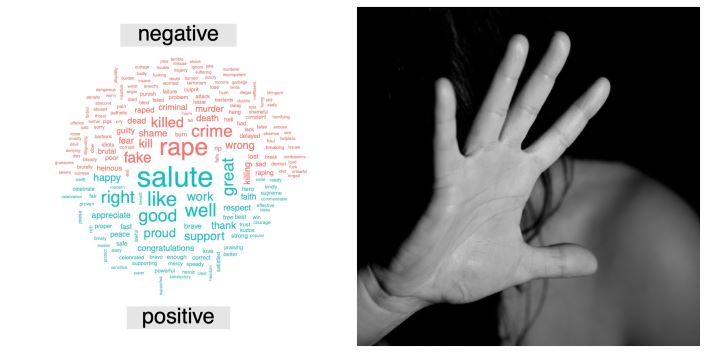Hyderabad Encounter: A sentiment analysis of public mood on day of encounter
Sentiment analysis of twitter users revealed that they showered salutes on Hyderabad police for eliminating alleged gang rapists of the veterinary doctor but only a few believe in cops’ version of successive events leading to encounter.

- Country:
- India
On December 6, India witnessed an unprecedented heroic welcome to the police personnel for neutralizing all the four accused of horrendous gang rape and murder of a veterinary doctor in the city. Though depicted in several Bollywood films, such welcome celebrations for police personnel involved in an encounter were a new phenomenon in real life.
The apprehensions were also raised from several quarters. Is India really moving towards a police state? Do people have more faith in the police than judiciary? There were several questions floating all around.
VisionRI deciphered the public mood on Hyderabad encounter by doing sentiment analysis through a scientifically proven methodology. The results revealed some new aspects of the public sentiments which were unheard off in the traditional prime time television discussions.
‘Salute’ highest for police but only a few buy ‘escape’ theory
The Twitter users, throughout the day, showered very high degree of praise and respect for police and the ‘justice’, it had delivered. The buzz word for respect to police was ‘salute’ which dominated the sentiment of Twitter users throughout the day. Besides, words such as 'proud', 'kudos', 'faith' and 'sir' were also used. The people also used words like salute, proud, good, happy to express their joy on the encounter throughout the day. However, these praises for police were on neutralizing the culprits but a few believes the story of culprits who were allegedly trying to run away and thus killed in the encounter.
On the incident of the encounter on December 6, the anticipation on what had happened and whether accused were trying to escape was seen as a distant possibility. In the sentiment analysis, the word ‘escape’ was 18th among the top 20 words used for anticipation on happening of encounter. The anticipation about judiciary interfering into the matter was the highest. After the police addressed a press conference and explained the situations leading to the encounter, the anticipation on ‘escape’ marginally improved to 17th rank. However, it again fell to 18th by 8 pm in the evening on the same day. The lack of popularity about police’s description of events was probably due to two main reasons – the human rights activists and journalists started questioning the police version and media debates were started to find out loopholes. This indicates towards the inability of the police to answer the questions raised by the critics.
Though the word ‘fake’ was also used for the encounter, we also observed negative sentiments towards using the word ‘fake’. The negative sentiment for the word ‘fake’ was at 6th rank in the morning which rose to 4th rank in the afternoon but went down to 5th rank by the night on the same day.

Had the police not acted on time, the culprits would have escaped? This sense of fear is also very low among Twitter users. However, they were highly convinced that the encounter will instil fear of police among the rapists as a fear factor on ‘police’ was highest throughout the day in the tweets used by Twitter users to express their views on Hyderabad Police.
Anger against Court
In a clear indication of much-warranted reform in the modern judiciary, the people also expressed anger against the court possibly due to lengthy process of hearings which is reportedly one of the major reasons for skyrocketing rape and sexual crimes against women. The analysis also shows an increasing trend of anger against the court. As the news of encounter broke out, the highest level of anger was seen against the accused and rape while anger against the court was a 5th rank and 18th against the police for shooting the accused. Later in the day, the court rose to the third rank in receiving the public anger.
The analysis also shows decreasing the trust of people in law, system and judiciary as these words were ranked below in ‘trust’ than ‘police’ and ‘justice’.
Disgust higher on rape than murder
The sentiment analysis shows the highest level of disgust on rape among twitter users which were 2 to 4 times higher than murder in all the three-time intervals used in the analysis. Furthermore, the sentiment of surprise on the word ‘shot’ stood on 4th rank in the period of study while a few also expressed surprise on ‘celebrations’ as well. Though sentiment of sadness was highest on rape and murder, a few also expressed sadness on ‘shot’. In the morning hours, the sadness on ‘shot’ was on 6th rank which rose to 5th by the afternoon but again slipped to 9th rank by the night. Interestingly, the sentiment of surprise on ‘celebrations’ was a distant 10th in the morning, 14th in afternoon and 19th in the night.
Though the incident was in Hyderabad, the people throughout the country participated in expressing their sentiments. This is evident from the fact that the tweets in the English language were the highest and almost double than Hindi. However, tweets in the Telugu, the regional language of Telangana, were minimum. The Twitter users also expressed their views in Tamil, Marathi and some unidentified languages.
METHODOLOGY
The sentimental analysis is based on the data extracted from twitter hashtag(s) #HyderabadPolice that started trending in the Twitter-sphere since Friday morning immediately after the news of Hyderabad encounter broke out at around 6 am on Friday, December 6, 2019. The exercise aimed to analyze the sentiment of Twitter users inter-temporal. We collected tweets through random sampling for three-time intervals - 6 am to 10 am, 11 am to 3 pm and 4 pm to 8 pm. In these three-time zones, 15,000 tweets were extracted from twitter using API (application programing interface). The tweets were subjected through three methods of natural language processing – BING lexicon, NRC lexicon and AFINN lexicon – for sentiment analysis.
Research Team: J. P. Singh, Editor-in-Chief, Neeraj Singh Mehta, Technical Lead, Esham Chatterjee, Assistant Manager, Economic Studies and Planning, Siddheshwar Shukla, Associate Editor, and Senior Sub-Editors, Parag Narang and Subhro Prakash Ghosh.
Disclaimer: The conclusions drawn in the sentiment analysis are subject to technological limitations of data extraction and methodology(ies) used for data processing. This study is based on analysis of tweets only and the retweets were not taken into account. All the available precautions have been made to maintain the objectivity of the research and its presentation in a scientific fashion.
- FIRST PUBLISHED IN:
- Devdiscourse
ALSO READ
US Senate panel chair issues subpoena in Supreme Court ethics probe
"Have we taken control of courts...agencies doing their job": Rajnath on Opposition allegations over arrest of Kejriwal, other leaders
Excise scam: CBI produces BRS leader K Kavitha before Delhi court; seeks 5-day custody.
Excise scam: Delhi court reserves order on CBI's plea seeking K Kavitha's five-day custody
Excise scam: K Kavitha's counsel opposes CBI's plea before Delhi court seeking her custodial interrogation.

 Devdiscourse News Desk
Devdiscourse News Desk









